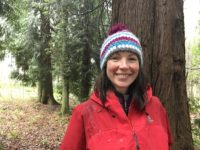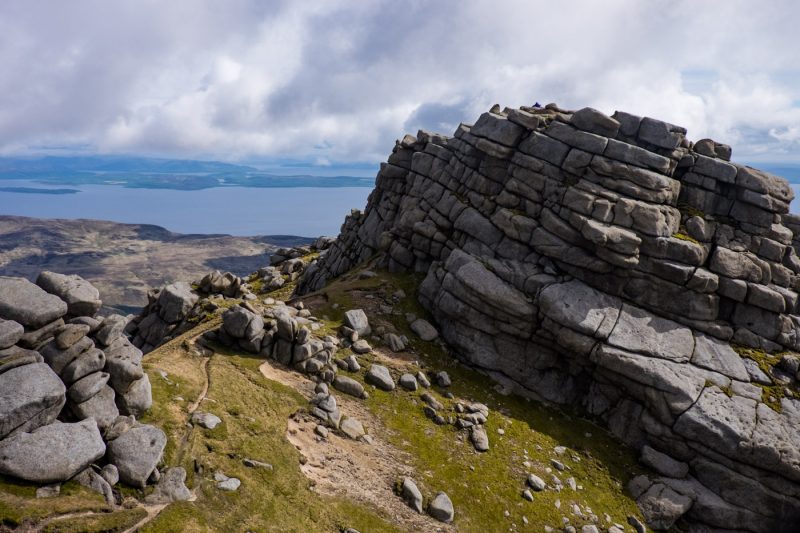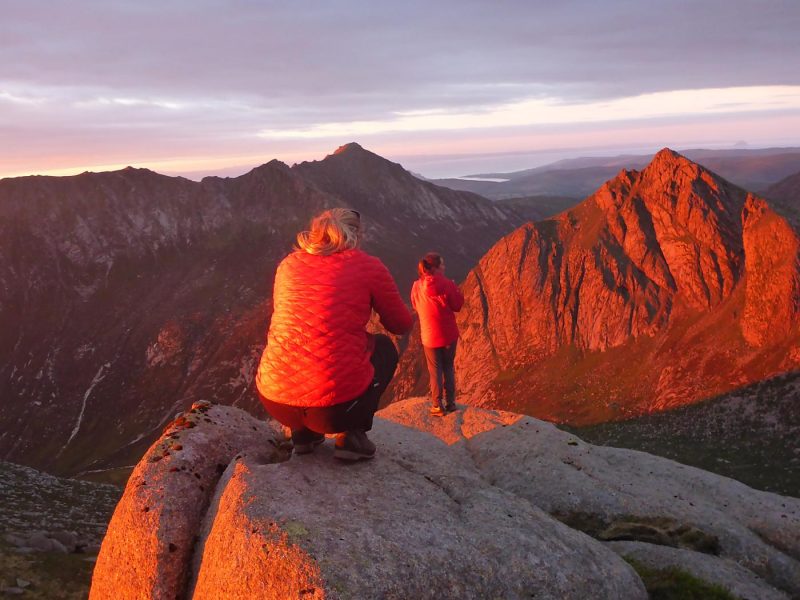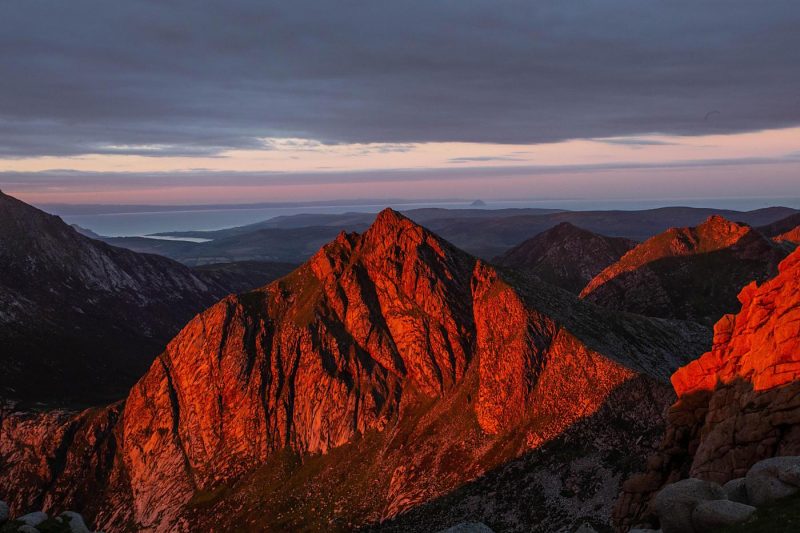
Caisteal Abhail on the Isle of Arran has one of Scotland’s finest views, overlooking the incredible granite pyramid of Cir Mhor. Lucy Wallace – a member of Arran Mountain Rescue team and the current president of Ramblers Scotland – longs for the day when she can finally return.
We’ve been separated from the mountains for so long. I’m sure I’m not alone in feeling them missing from my life. I allow my mind to wander freely amongst the summits, as my body waits, patiently, for that time when I can physically be there. It’s a practice that brings pain, like loss, but also pleasure, like the memory of a taste, something delicious remembered by the mouth, but impossible to have.
My head is full of mountains, but there is one summit that calls me back. The lofty height of Caisteal Abhail on Arran is a place embedded deep. If memories are held in the neural networks of our brains, then it is in the very stuff of me. I can take myself there right now. With no effort, I feel the short, stiff sedges and sharp granite crystals under my fingers. I can explore the stacked summit blocks, and lean myself against a rock to contemplate the view.

And what a view! On a clear day, take a seat at the top of one of the gullies above Portcullis Buttress, and gaze out. Looking south, the eye is drawn immediately to the gloomy cliffs of Cir Mhor, crowded into a darkening apex, it is connected by the perfect arc of Hunters Ridge, a rim of rock skimming the edge of Coire na h-Uaimh. If I turn around, I can look west to the Pirnmill Hills, and beyond Kintyre and the sea, to their skyline reflection, the Paps of Jura. To the north is the bay of Lochranza, the Kilbrannan Sound, and a smudge of the Highlands on the horizon.
But it is this view to Cir Mhor that holds me here. It’s a view with commanding dimensions as well as beauty: the depth of the coire, the changing light on the angles of rock, the fissures, slabs and meadows resting as if propped up against the face of the mountain. There’s a scenic backdrop provided by the long ridge of Goatfell, and the swoop of The Saddle between provides some scale. To the west, the onward march of A’Chir and The Three Beinns gives a sense of rhythm to it all. There is, to me even in the shade of imperfect recall, nowhere more powerful, more mind bending, than this.

There’s no easy way to the summit of Caisteal Abhail, but with four possible approaches, some are more straightforward than others. Most will visit via a horseshoe of North Glen Sannox, either by the steady ascent of Sail an Im, or the abrupt northern ridge of Cuithe Mheadhonach. The adventurous may include a traverse of Ceum na Caillich, the “Witches Step”, a defile of rotten rock that takes good route finding to pass safely. The southern approach links to the main part of the Goatfell Range via Hunter’s Ridge, whose Gaelic version; Leac an Tobair or “Ledge of the Fountain”, notes a bubbling spring that spouts forth clear water at 700m altitude.
The summit area is a maze of blocks and tors giving the mountain it’s anglicised name “The Castles”. Viewed from the south, three buttresses push up from the rounded top to resemble a trident shape. Thus Caisteal Abhail is thought to mean literally the “Castle of the Fork”, or it could be a hybridisation of Gaelic and Norse (as Goatfell is also likely to be), and translate as “Castle of the High Fell”. All three names work for me. It is trident-shaped fortress of the high places, a summit hard won and easy to linger on. The tallest tor has just one safe way on to it, via a short scramble that leads to a small flat top with big drops on all sides. There is no trig point to mark it, just a small Ordnance Survey bolt cemented in to the granite, at 859m above sea level.

Between the cliffs are meadows of matted sedge. Here, the shape of the hill is gentle, almost flat. It’s a lovely place to linger, especially on a sunny day. I’ve spent hazy afternoons up here lost to the world, listening to the rise and fall of the meadow pipits, and it was in this place that I hatched a plan for my first ever summit camp.
I have one friend who is guaranteed to join me on my most uncomfortable adventures. Photographer Kirstie Smith is an aficionado of the nighttime foray, an artist who will endure anything for the perfect light.

We were met by our friend Clare, and the three of us set off on a balmy midsummer evening into a sunset of liquid gold. We arrived on the top at twilight, as the evening chilled and a breeze gathered pace. We squeezed our tents into the lee of the summit block, and tried to sleep through our excitement for the few short hours until daybreak. At the first sign of light we rose, shivering, wrapped in sleeping bags and clutching mugs of steaming coffee. The dawn came in a flush of fiery intensity that poured across the face of Cir Mhor. We watched as the flames spread, igniting the mountains behind, until the whole world was burning with ruby light.
This place is crowded with recollections. As I allow my thoughts to wander, I stumble across them: wheeling peregrines, a compass bearing in the mist, scurrying dotterel, a cold day of rock climbing on the Portcullis, numb fingers on sharp rock. There was that bright morning that I met Kirstie and her dogs on the ridge after she’d spent a night out, and that sodden dawn that I lay next to the summit bolt, sobbing in relief after a stormy camp alone in The Saddle. A handful of mountain rescue callouts stand out like landmarks in my mind. Some with good outcomes, some with sad, I greet them like old friends as I pass them by.

Looking across to Cir Mhor I see more memories. In summer, this face is dank and dangerous, but in winter it’s a playground. The Western Stone-shoot will go in soft snow and my husband Wally and I have climbed it many times. To the left is Bypass Route, a grade II winter climb that rarely comes in to condition. The day we climbed it, we were doubly blessed. Descending from our climb at dusk, we watched a fireball rocket out of the sky, over Hunter’s Ridge, before fizzling out above the coire. I can still smell the hot stench of brimstone and scorched minerals, but my mind plays tricks and I’m not completely sure that this actually happened. If it was a hallucination, then we both dreamed up flaming meteorites that night.
This is a legendary landscape. Caisteal Abhail is a fortress that holds not just my memories, but also the folklore of generations. The profile of The Castles forms the belly of the “Sleeping Warrior”, a giant who dozes on his back when Arran is viewed from the north. The cleft of the Witches Step outlines the brim of his helmet and the bridge of his nose. He snores, lips pursed in exhalation, a sprawling arm spreading from his shoulder, the length of Cuithe Mheadhonach.
Sleeping hero myths flourish in British story telling traditions, but the identity of this warrior is lost. A clue lies in the name of the peak at his head at the far end of the ridge from The Castles, but it raises more questions than it answers. Suidhe Fhearghas is the “Seat of Fergus”, a shapely peak with wild roses growing on its sunny steeps. Perhaps this entire ridge belongs to Fergus Mòr, ancient ruler of Dál Riata, a blessed kingdom whose reach extended as far south as Arran? Fergus was affiliated to King Arthur, a different king, who sleeps under a hill in Wales, to rise again at a time of need. I wonder what Fergus and Arthur would make of our current predicament? And who is the witch that guards the step?

Today, the mountain inspires Corbett baggers and other hill walkers but remains a quiet place to visit. There’s no clearly defined passage on to the lower slopes, and no waymarks. There are river crossings to negotiate, rough bogs to cross, and in poor visibility, critical compass bearings to take. Even in fine weather, a deer trod will quickly lead the unwary in to a steep gravelly gully, or to a dead end drop. It’s a wild place, and it belongs to the wild life that lives here. Ravens dance and stoop in the updrafts between the gullies. Deer graze in the solitude of the Leac an Tobair. If you rest a while on the climb up Sail an Im, you may hear the lonely cry of a red-throated diver, or spy the soaring outline of a golden eagle on the hunt for grouse.
Today I’m a far cry from this wild and free landscape. Sitting here in my living room, I find myself surrounded by a degree of domesticity that is completely strange to my adult life. But even here, the The Castles have pride of place. Above my head, a pen and ink drawing by a local artist carves out in stark black and white, the very view that I desire most in all the world. Angela Elliott Walker’s monochrome vision of Cir Mhor from Caisteal Abhail captures perfectly the sweep of light and shadow playing over the shapes of the mountains. To draw it, she must have sat in reverie in the very place that my mind sits now.
It’s a place of stillness, a place of loneliness even, whether physically alone, or with friends, a place that invites the deepest of reflections.

Postscript:
As we move out of total lockdown, and in to “Phase 1” of a return to some sort of normality, it is tempting to rush to these high places, as we would love to rush to our family to hold them, after months of separation. Sadly, I wont be, just yet. The five-mile guidance from the Scottish Government would seem to keep us apart a little longer. Not only that, but the risks that we take when we do head for the hills will be that bit more nuanced, with the threat of coronavirus complicating everything. It will be many weeks or even months before I’m back to leading clients in these high hills again, and I plan to return to them with extreme caution. Obvious risks to rural communities and mountain rescue volunteers aside, the wild places have been without our presence for many months now. Young animals will have been raised without fear of humans. The summits have truly belonged to the creatures that live there, and I feel reluctant to grab them back too fast. When I do go, it will be a delicious experience, to be savoured carefully, and not rushed.
